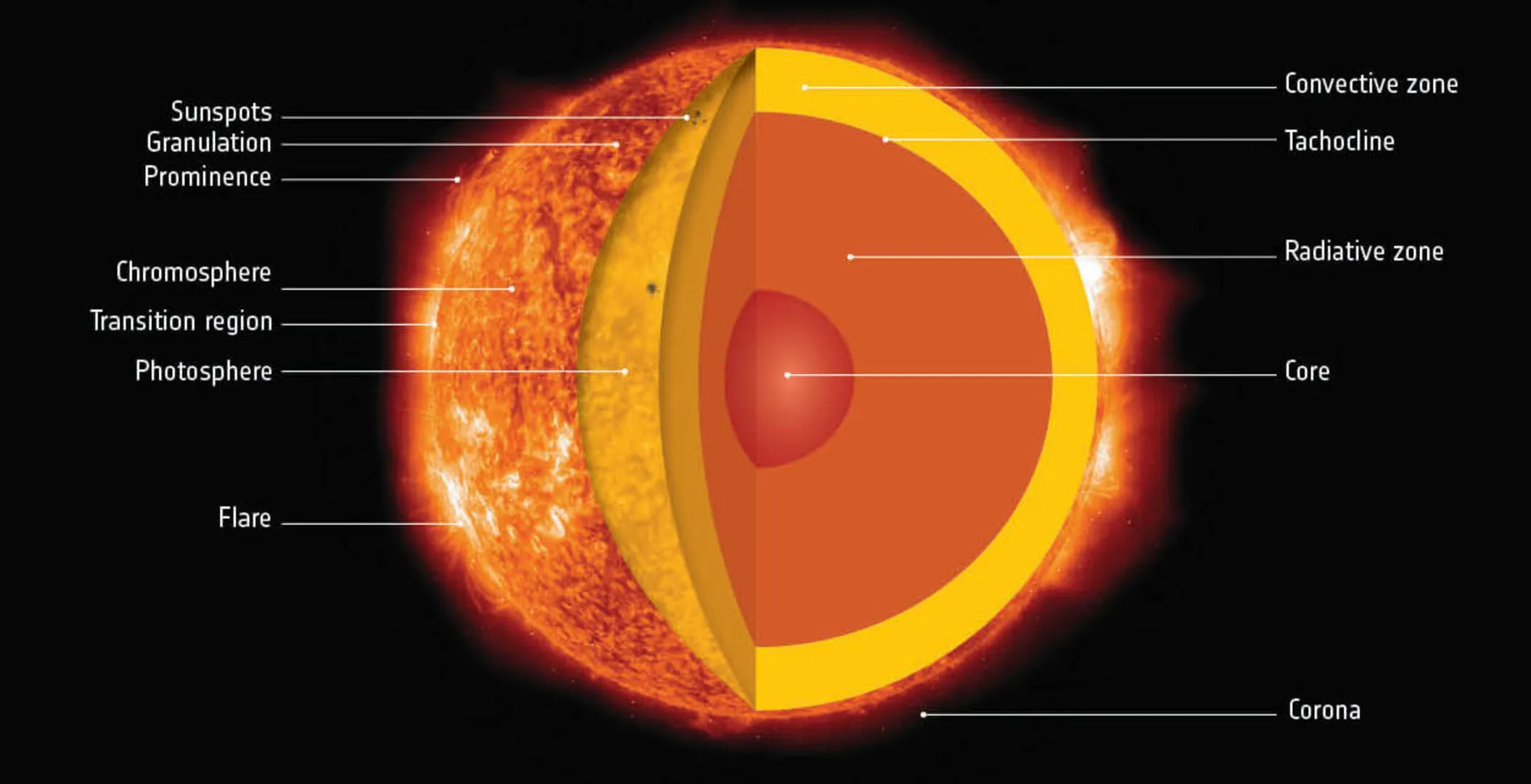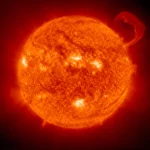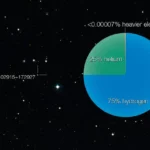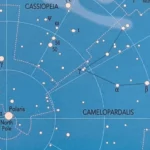Where did our shining star come from? For thousands of years, we’ve been amazed by the sun. It gives us warmth, light, and life. So, how did it come to be? Let’s take a journey back in time to the beginning of the universe to find out the secret of the sun’s birth.
The Sun’s Origins: A Celestial Tale
Imagine a vast cloud of stuff floating in space, like a cosmic soup made of gases and dust. Gravity, the invisible glue of the universe, gives it a shake, causing it to start spinning like a cosmic whirlpool.
As the whirlpool spins faster, it starts to flatten out into a disk, just like a pancake. And in the middle, a giant blob of stuff starts to get all hot and bothered. It’s like a cosmic baby bump that’s about to give birth to something big.
Inside the baby bump, a special party is going on called nuclear fusion. That’s where hydrogen, the most common ingredient in the cosmic soup, starts turning into helium, releasing a ton of energy. It’s like burning fuel in a cosmic engine.
As the party keeps going, the baby bump grows bigger and hotter until it finally explodes into life: a brand-new star is born! And that, my friend, is our very own Sun.
The Sun is now a glowing ball of fire, like a cosmic bonfire, burning through its hydrogen fuel. It’s like a middle-aged star, not too young and not too old. But like all good things, it won’t last forever. One day, the Sun will run out of hydrogen fuel and go through a series of changes, ending up as a white dwarf star, a small, glowing ember of its former glory.
So, there you have it, the incredible story of how the Sun came to be. It’s a cosmic journey that has shaped our solar system and given us the light and warmth we need to thrive.
Did you know that about 1.3 million how many earths can fit in the sun? That’s more than the population of China! And if you’re a Bitlife fan, you’ll be surprised to know that it’s even more how many earths can fit in the sun bitlife! The sun is absolutely massive compared to the earth, how big is the sun compared to the earth is really mind-boggling. In fact, it’s so big that it could fit over a million Earths inside it at once! If you’re interested in learning more about the sun and its place in space, be sure to check out our article on sun in space.
How Long Did It Take for the Sun to Form After Molecular Cloud Collapse?
Imagine a colossal cloud of gas and dust, swirling and condensing in the vastness of space. That’s how our Sun began its journey. About 4.6 billion years ago, this cosmic cloud began to collapse under its own gravity, spiraling inward and heating up.
As the center of the cloud got hotter and denser, it eventually reached a point of no return. Nuclear fusion ignited, unleashing a torrent of energy that transformed hydrogen atoms into helium atoms. This fusion process is what powers the Sun and makes it shine.
However, the Sun didn’t just pop into existence like a lightbulb. It took some time for it to settle into its current stable state. After the initial collapse, it took an estimated 50 million years for the Sun to transition from a chaotic, protostar to the main sequence star we rely on today.
A Timeline of the Sun’s Formation:
| Stage | Timeframe |
|---|---|
| Molecular cloud collapse | 4.6 billion years ago |
| Ignition of nuclear fusion | Soon after collapse |
| Transition to main sequence star | 50 million years |
Key Takeaways:
- The Sun emerged from a massive molecular cloud.
- Nuclear fusion drives the Sun’s energy output.
- It took millions of years for the Sun to reach maturity after the cloud’s collapse.
What’s the Role of Gravity?
You know that invisible force that keeps you grounded and keeps the planets in our solar system humming along? That’s gravity, folks! It’s like the cosmic glue that holds everything together.
Picture our solar system as a celestial dance party, with the sun playing the role of the ultimate DJ. Its massive weight creates a gravity field that keeps the planets swirling around it like dancers on a spinning floor. This gravity groove ensures that the Earth and its celestial buddies stay in sync, preventing any chaotic detours.
But gravity isn’t just a party trick. It’s also the secret ingredient behind the Earth’s habitable conditions. Gravity keeps us at the perfect distance from the sun, not too close where we’d fry like an egg on a skillet, and not too far where we’d freeze like an ice cube in a freezer. It also helps regulate our planet’s temperature and climate, providing us with the cozy home we’ve come to appreciate.
Nuclear Fusion: Unveiling the Sun’s Energy Secret
Imagine the Sun as a giant ball of glowing gas, humming with energy that reaches us every day. How does it keep going? Enter nuclear fusion, the secret power behind the Sun’s shining brilliance.
The heart of the Sun is a bustling metropolis of atomic nuclei, mostly hydrogen. Picture these tiny particles like tiny magnets, with a positive charge. Under the intense heat and pressure at the Sun’s core, these magnets are forced together. It’s like trying to push two north ends of magnets together, except in this case, the force of gravity is so strong that it overcomes the magnetic repulsion.
When protons, as these tiny magnets are called, finally get close enough, they fuse into a helium nucleus, a slightly heavier and more energetic version of their former selves. This fusion releases an enormous burst of energy in the form of gamma rays. These energy packets then bounce around, crashing into other particles and turning into light, heat, and other forms of energy.
This nuclear fusion process doesn’t happen all at once. It’s like a chain reaction. The energy released from one fusion reaction fuels the next, creating a constant flow of power that keeps the Sun shining.
And just like a house needs a steady supply of electricity, the Sun needs a steady supply of hydrogen fuel. Luckily, the Sun is constantly replenishing its hydrogen stores by fusing hydrogen in its outer layers. It’s like a celestial recycling system, ensuring the Sun’s energy supply for billions of years to come.
Here’s a breakdown of the key points:
| Feature | Explanation |
|---|---|
| Nuclear Fusion | Combining atomic nuclei to release energy |
| Proton-Proton Chain | The Sun’s specific fusion reaction |
| Energy Balance | Fusion energy keeps the Sun from collapsing |
| Hydrogen Fuel | The Sun’s energy source, constantly replenished |
FAQ
Q1: How did the sun form?
A1: The Sun formed from the gravitational collapse of a giant molecular cloud composed primarily of hydrogen and helium. As the cloud collapsed, it began to rotate, forming a flattened disk. The Sun formed at the center of this disk through the accretion of mass.
Q2: What is the Sun’s energy source?
A2: The Sun’s energy is generated through nuclear fusion reactions that occur in its core. Hydrogen atoms fuse to form helium atoms, releasing vast amounts of energy in the process. This energy is radiated into space in the form of light, heat, and other forms of electromagnetic radiation.
Q3: How old is the Sun?
A3: The Sun is approximately 4.6 billion years old. It is considered a middle-aged star and is expected to continue shining for another 5 billion years before entering its final stages of life.
Q4: How does the Sun’s gravity affect the solar system?
A4: The Sun’s gravity is the primary force that holds the planets, asteroids, and other objects in the solar system in place. It keeps the planets in orbit around the Sun and prevents them from drifting away. The Sun’s gravity also affects the tides on Earth and other planets.
Q5: What is the composition of the Sun?
A5: The Sun is primarily composed of hydrogen (about 73%) and helium (about 25%). Trace amounts of other elements, such as oxygen, carbon, neon, and iron, are also present.
- Unlock Filipino Culture: A Deep Dive into Traditions and Practices - April 23, 2025
- Unlock Spanish Culture: Insights & Opportunities Now - April 23, 2025
- White Spirit Uses & Substitutes: A Deep Dive for Pros & DIYers - April 23, 2025
















